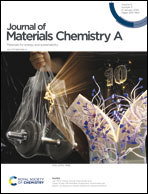A donor–acceptor hydrogen-bonded organic framework with the turn-on fluorescence response of phenethylamine (drug analogue) via single-crystal to single-crystal transformation†
Abstract
A water-stable hydrogen-bonded organic framework (TPPA-TMA) has been constructed from tris(4-(pyridin-4-yl)phenyl)amine (TPPA) and 1,3,5-benzenetricarboxylic acid (H3TMA), which exhibited highly efficient turn-on fluorescence sensing of phenylethylamine (PEA, drug analogue) in water with a detection limit of 2.56 μM and was selective toward PEA in the presence of aromatic interferents. The luminescence mechanism was demonstrated by the single crystal X-ray diffraction (SCXRD) test and the density functional theory (DFT) calculations. Two single crystals (HOF-TPPA and PEA-TMA) were obtained through the suspension of TPPA-TMA in PEA. SCXRD analysis showed that HOF-TPPA consists of TPPA and water molecules, indicating the structural transformation of TPPA-TMA after sensing PEA. The single crystal structure of PEA-TMA suggested that protonated PEA could combine with H3TMA in TPPA-TMA. In addition, DFT calculations further demonstrated that PEA induced the transformation of TPPA-TMA into HOF-TPPA through the synergistic effect of hydrogen bonding and electrostatic action.

- This article is part of the themed collection: 2024 Journal of Materials Chemistry A HOT Papers


 Please wait while we load your content...
Please wait while we load your content...